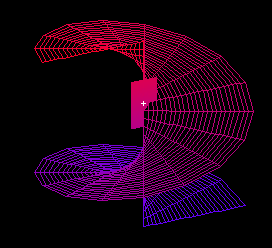
When using a parametric surface, we define the tangent plane to be the plane passing through f(u0,v0) and parallel to the partial derivatives with respect to both u and v. The plane is given parametrically by:
t(s,t) = s(partial w/ respect to u at (u0,v0)) + t(partial w/ respect to v at (u0,v0)) + f(u0,v0)
f(u,v) = (ucos v, usin v, v), where u=0..2, and v=0..2*Pi at (u,v) = (1, 2*Pi)
partial of u = (cos v, sinv, 0) = (1, 0, 0)
partial of v = (-usinv, ucos v, 1) = (0, 1, 1)
t(s,t) = s(1, 0, 0) + t(0, 1, 1) + (1, 0, 2*Pi) = (s+1, t, t+2*Pi) for s=-infinity..infinity, t=-infinity..infinity
NOTE: Use the variables s and t in the Maple ParamTan command (ParamTan will not recognize u and v)
A. Find the partial derivatives with respect to s and t, and evaluate them at (s0,t0)=(1, 1), our point of interest.
B. These two vectors are the basis vectors for your plane. Turn them into a plane. Hint: this is a vector valued function.
C. Sketch your surface and tangent plane around your point (s0,t0)=(1, 1). You can use maple if you really want to, we allow it. : )
D. Check your answer using the command ParamTan. (If you have not already pasted in the maple code that auxilliary functions, then do so now.) The syntax is as follows:
ParamTan (function defined as 3 vector, s=smin..smax, t=tmin..tmax,point=[s0,t0]);
Note: These are the actual steps that Maple is going through when it calculates the plane.
Back: tangent planes to graphs